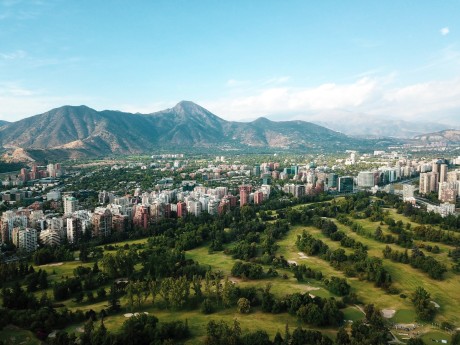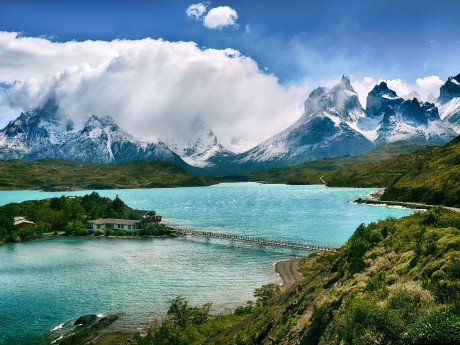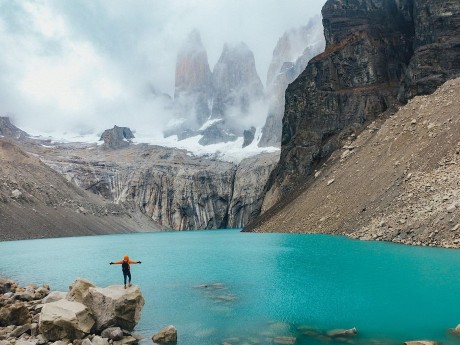Chile: Santiago & Puerto Natales
Your Chilean journey commences in Santiago, the vibrant capital. Visit historic neighbourhoods like Barrio Bellavista and Barrio Lastarria, filled with artistic flair, cafes, and boutiques. Explore the stunning La Moneda Palace and hike or take the funicular to the top of Cerro San Cristóbal for panoramic city views. Sample Chilean wines in the nearby Maipo Valley.
Read more
Your Chilean journey commences in Santiago, the vibrant capital. Visit historic neighbourhoods like Barrio Bellavista and Barrio Lastarria, filled with artistic flair, cafes, and boutiques. Explore the stunning La Moneda Palace and hike or take the funicular to the top of Cerro San Cristóbal for panoramic city views. Sample Chilean wines in the nearby Maipo Valley. In Puerto Natales, discover Torres del Paine National Park, known for its iconic granite peaks, pristine lakes, and diverse wildlife. Visit the Milodon Cave, a natural monument that once sheltered prehistoric creatures. Enjoy the local cuisine, including the traditional Patagonian lamb. Each destination showcases Chile's diverse landscapes, culture, and natural wonders, making it a captivating journey for travellers seeking a variety of experiences. Waterviews strives to offer accommodation options within walking distance of water and/or in an area of touristic interest. Our prices include taxes (but excludes local tourist taxes). Customize your trip to your personal preferences with optional activities (hit the “Add Activities’’) or change hotels, etc. Contact us for customization at no extra cost at: Service@waterviewstravel.com
Destinations
- Santiago de Chile
- Puerto Natales
Itinerary
Santiago de Chile

Surrounded by the snow-capped Andes mountains, Chile’s capital and largest city is a vibrant metropolis with a lot to offer. Santiago is filled with countless cultural attractions, and is home to the country’s top restaurants, museums, theatres and galleries as well as a world-class nightlife scene. Modern skyscrapers blend with colonial-era buildings in the city’s vibrant centre, and those who want a break from the hustle and bustle can relax in one of its sprawling green parks.
Read more
Surrounded by the snow-capped Andes mountains, Chile’s capital and largest city is a vibrant metropolis with a lot to offer. Santiago is filled with countless cultural attractions, and is home to the country’s top restaurants, museums, theatres and galleries as well as a world-class nightlife scene. Modern skyscrapers blend with colonial-era buildings in the city’s vibrant centre, and those who want a break from the hustle and bustle can relax in one of its sprawling green parks.
Additional Information
Santiago is a fast-growing city in the Santiago Región Metropolitana, in the central valley of Chile between the Andes mountain range to the east and the Coastal Range to the west. The metropolitan area has about 7 million inhabitants.
Founded in 1541 as Santiago de Nueva Extremadura by the Spaniard Pedro de Valdivia, it has been the heart of the country since colonial times and has evolved to the cosmopolitan city it is today. For visitors it's both the gateway to the country and a destination in its own right with an eclectic architecture, a vibrant culinary and cultural scene, surrounded by the mighty Andes welcoming skiers, trekkers and friends of wine.
History
The Santiago valley has been inhabited for thousands of years by different tribes. The Inca empire, and with them the Inca road network, extended here in the late 15th century. Not long after emerged the Spanish conquistadors, and on February 12, 1541, Pedro de Valdivia founded "Santiago de Nueva Extremadura" as the capital of the Captaincy General of Chile. During the following centuries functioned as the headquarters of the Spanish for their wars against the native Mapuche people further south, during which time the city was ruined two times by earthquakes.
From the 19th century onwards, Santiago followed a similar path as many other South American cities. Independence was followed by rapid expansion and modernization and many of the city's major buildings, cultural institutions and parks were established at this time. Also the railway network to other parts of the country was greatly expanded. European immigration was from the 1930s onwards followed by immigrants from rural Chile and the city already had 3 million inhabitants by the middle of the 20th century.
The next major event in the city's history took place in 1973, when Marxist president Allende was ousted in a military coup. The military dictatorship that followed lasted until 1990. Today, Chile is a safe, democratic and stable country and one of the richest in Latin America.
Geography
Santiago sits in the middle of the Maipo river valley, at the place where it is joined by its tributary Mapocho, and the city is surrounded by mountains of various elevations, the highest of them Tupungato (6,570 m). Many of them are active volcanoes, and the soil has been covered in ash for millenia making it very fertile and high-quality grapes and other fruits are widely grown just outside the city.
The city sits between 400 and 540 meters above the sea level, but with many "hill islands" here and there including Santa Lucia, Cerro Calan and Cerro San Cristobal, the most emblematic top of the city. The Andes on the east side are noticeably higher than the Chilean Coastal Range on the west, wherefore east and west are often referred to as "up" or "down" by locals.
The administrative conurbation of Santiago is made up of 37 municipalities, of which the most important is Santiago Centro, where the main public institutions of the country and the old town are found. The east of the city is the financial center of the country.
Climate
Like most of the central part in the country, Santiago has a typical Mediterranean climate. The climate is chilly and rainy in the winter, and temperatures can fall to around 0°C at night. It very rarely snows in the city itself, and during the winter it will more likely be raining with snow falling to the east up in the Andes. It gets progressively hotter towards the summer. Summers are fairly dry although you may experience some humidity at times, and temperatures can surpass 35°C. Due to the relative lack of vegetation in the region, temperatures fluctuate wildly between day and night year-round. It is not uncommon to suffer from the heat in shorts and a short-sleeved shirt during the day but require a jacket at night.
Santiago is notorious for its poor air quality, which is due to the inversion effect in the basin and other factors. The air quality can be unhealthy in large part due to high concentrations of particulate matter (especially in the winter).
Visitor information
© Sourced from Wikivoyage
Puerto Natales

The gateway to the breathtaking Torres del Paine National Park, the port city of Puerto Natales is a popular stopover for visitors looking to explore Chile’s most picturesque nature. As well as being an excellent base for the surroundings, Puerto Natales offers a good range of amenities, with shops where you can buy trekking gear and an array of restaurants, cafes, bars and accommodation options as well as a great museum where you can learn about the region’s indigenous culture.
Read more
The gateway to the breathtaking Torres del Paine National Park, the port city of Puerto Natales is a popular stopover for visitors looking to explore Chile’s most picturesque nature. As well as being an excellent base for the surroundings, Puerto Natales offers a good range of amenities, with shops where you can buy trekking gear and an array of restaurants, cafes, bars and accommodation options as well as a great museum where you can learn about the region’s indigenous culture.
Additional Information
Puerto Natales features a couple of characteristics that visitors should be aware of. One is that the population is largely descended from immigrants from Chiloé, and the "chilote" tendencies (cooking, building style) are evident. Another characteristic is that there are very strong communist/leftist affiliations in this town, so take this into account by being careful with your conversations involving related politics. Aside from the Chilotes, you will find many surnames of British and Croatian descent.
Although not of very high interest as itself, Puerto Natales is an ideal basis for a trek in Torres del Paine National Park. Remember that the city is the last chance to get food (in the supermarkets) and gas at reasonable prices before the park, where you are to pay double for those goods.
The city is built along the very beautiful Señoret Channel, which connects Almirante Montt Gulf to the south with Última Esperanza Sound to the north.
The Navimag ferry ship to Puerto Montt departs from here.
Climate
Whatever the season you choose to travel, be prepared for harsh weather conditions, not only cold, but wind and strong sun. You can have the four seasons in the course of a day! During late spring and summer, it can get very windy.
Visitor information
© Sourced from Wikivoyage





